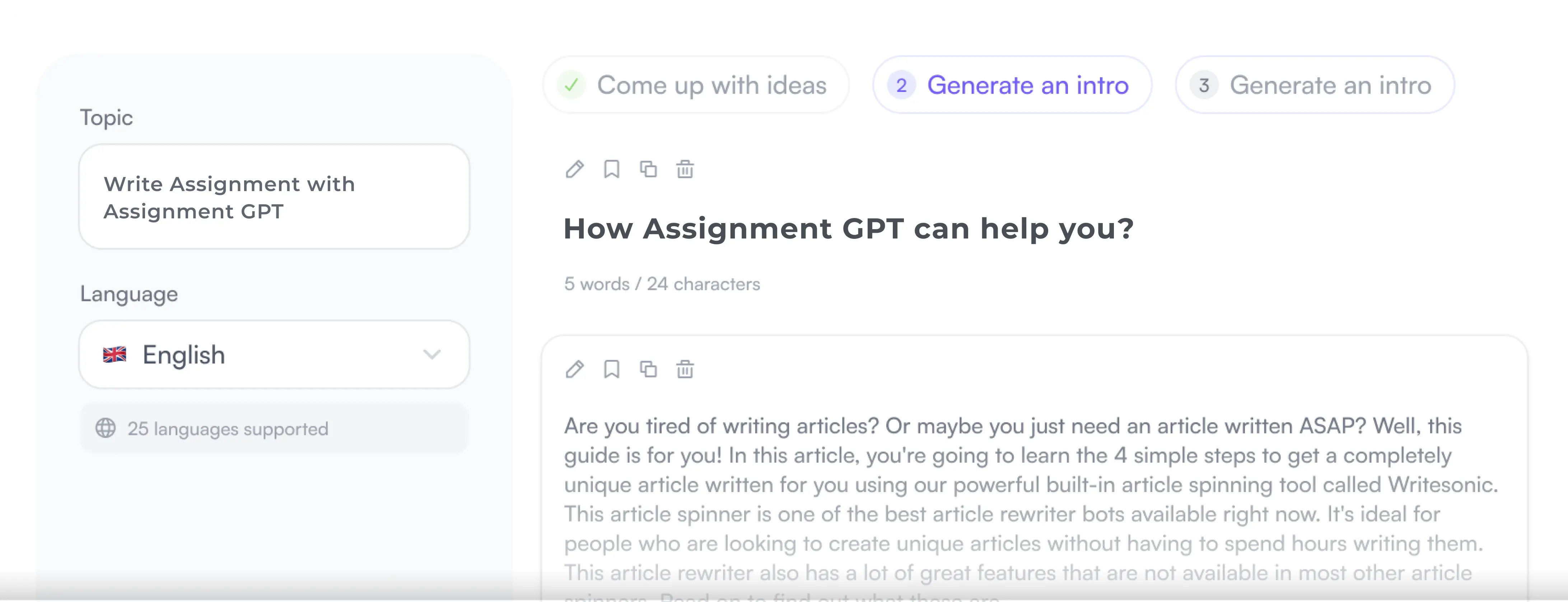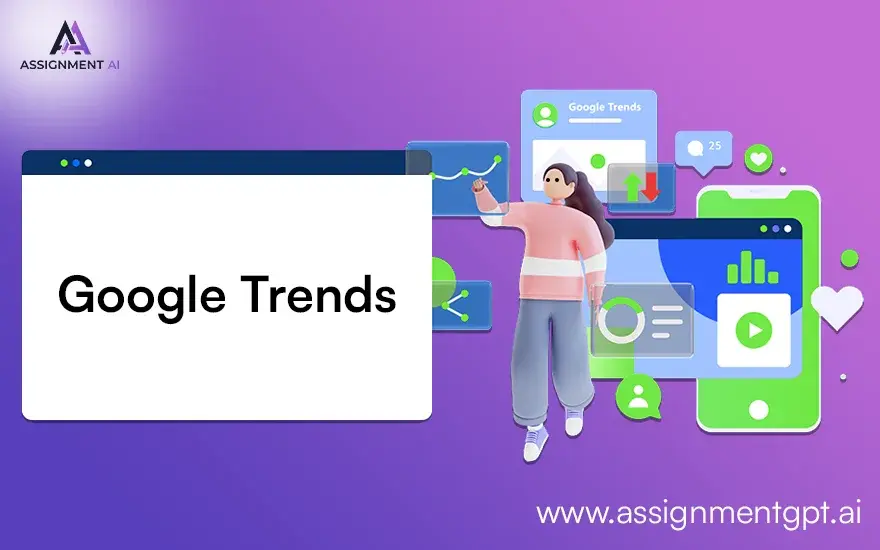AssignmentGPT Blogs
Google Trends is a robust system that monitors the fame of words typed into Google's search box over a period. It reveals data about search frequency and where users are based, helping to spot rising trends, assessing search terms, and examining changes in interest tied to different seasons. With data from the present and past, Google search trends assist those in marketing, research, and business to make decisions backed on solid information. Despite minor drawbacks, it is a treasured tool for grasping public interest and forming successful strategies.
Quick Summary
Google Trends, a tool that monitors Google search term popularity over time, is tremendously helpful. It gives up-to-the-minute reports, pinpoints new patterns, facilitates comparative evaluations, and doles out regional and seasonal specs. Its drawbacks include context absence, data broadness, restricted detail, and potential for misunderstanding. Even considering all that, it's a key tool for making savvy choices in marketing and research.
What Are Google Trends?
Google Trends acts as a handy tool to track the frequency of specific terms typed into Google's engine, compared to its overall search traffic within a set timeframe. Its main purpose is for researching keywords comparatively and recognizing increases in keyword searches when events occur.
Google Trends dishes out data tied to keywords. It offers details on search volume index and location details of those using search engines.
How to Use Google Trends
When you start using it to find trends, you'll first notice that Google search trends use a 0 – 100 score scale instead of search volume.
If you want to search for the number of search terms you want, you should use keyword tools to search: you can use a keyword chart from Google Ads, for example, to check for trending search terms the number is true.
A score of 1 indicates that the search terms are relatively popular, and 100 indicates the opposite, the highest point indicating that the search terms are relatively popular. A score of 0 tells you that there is not enough data to use in the search term.
The advantage of comparative scoring is that it allows you to see a wide range of trends, even
Advantages of Google Trends
'Google Trends' brings plenty of perks to the table, crucial for marketers, researchers, and firms alike. Let's delve into its prime merits:
Real-time insights into public interest
Google Trends is like a window into what's hot right now. It shows you what folks all over are buzzing about, as it happens. That's gold for writers and sellers. They can quickly see a shift in people's focus, which helps them stay ahead and keep in tune with happenings and shopping trends.
Discovering emerging trends
The platform shines in spotting hot keywords before they become popular. This function is very useful for companies and content makers eager to seize new chances and harmonize their plans with blossoming demands.
Comparative analysis
Google Trends lets folks contrast how often different search queries pop up over various periods and zones. This side-by-side review aids in grasping the importance of subjects, brands, or products relative to each other. This is a must-have tool for smart choices in marketing and research.
Geographical insights
Google Trends shines with its feature to divide search information by area. It lets people see what's hot in different spots. That can help companies shape their ads to fit places where people are most interested.
Seasonal trend analysis
Google Trends is a tool that unveils how people's interest in certain topics changes with the seasons. By grasping these shifts, businesses can tailor their offerings and advertising efforts. This aligns with when users are curious, boosting interaction and efficiency.
Integration with other Google tools
You can merge Google Trends with other Google tools, giving a sweeping look at search info. This mix allows for an in-depth study and improves tracking trends on diverse platforms, like Google News and YouTube. It greatly boosts the info available for marketing plans.
Historical data analysis
This tool provides historical search info. It helps to spot trends over time and shifts in how people behave. History like this is so important for businesses. They can see how interests have changed and work out plans based on this.
Also read this article : Google Launches Their New AI Model Called Gemini AI Will It Take down GPT-4?
Disadvantanges of Google Trends
Limitations of Google Trends include its reliance on search data, which may not fully represent broader trends, and its inability to provide detailed demographic or contextual insights behind search patterns.
Lack of context in search queries
A downside to Google Trends is its tendency to give stats without backstory. Looking at search findings, you're left guessing why a specific keyword ranks high. This missing backstory can cause wrong assumptions, especially if you're using Google Trends as your only research tool. Unearthing the 'why' behind these patterns usually needs more digging and varied sources of info.
Data generalization issues
Google Trends often simplifies data, mainly for less common search phrases. This means the frequency of searches for unique subjects might not be correctly displayed, possibly affecting evaluations. For businesses or folks studying detailed areas, this could lessen the effectiveness of the tool in grasping particular market areas.
Limited granularity in data
Google Trends provides regional specifics. Yet, this information sometimes doesn't dive deep enough for precise exploration. Occasionally, you may need more finely-tuned, place-based facts than Google Trends can offer. Such limits can be tough for local companies or research needing in-depth geographical wisdom.
Potential for misinterpretation
Google Trends info can occasionally be misunderstood, mainly when figuring out why people are searching. For example, more searches for a particular disease don't always mean a sudden outbreak; up-to-date news could be causing it. So, it's vital to look at Google Trends info critically and double-check with other places to stop wrong assumptions.
Conclusion
Google Trends, an exceptional instrument for those in marketing, research, or business fields, uses search info to gauge the public's interest and actions. It offers immediate insights, the ability to see upcoming trends, features for comparing analyses, localized breakdowns, seasonal trend examinations, and ties in nicely with other Google tools - quite a handy tool overall. It's not perfect, though, with issues like missing context for search terms, problems generalizing data, limited detail, and the potential for misunderstandings. Despite these, Google trending searches are still a strong instrument for guiding decisions based on search trends. If users harness its benefits and keep its shortcomings in mind, they can dig deeper into trends and shape their strategies in a better way.
FAQs
1. What are Google Trends?
2. How do Google Trends searches score?
3. What are the benefits of using Google Trends?
4. Are there restrictions on Google Trends?
5. How can I use Google Trends for keyword research?
Content writer at @AssignmentGPT
Rashi Vashisth is a content writer who helps brands put their thoughts into words. She creates blogs, website content, and brand stories that are easy to understand and feel genuine. Her writing style focuses on keeping things clear and making sure the message connects with the right people.
Master AI with
AssignmentGPT!
Get exclusive access to insider AI stories, tips and tricks. Sign up to the newsletter and be in the know!

Transform Your Studies with the Power of AssignmentGPT
Empower your academic pursuits with tools to enhance your learning speed and optimize your productivity, enabling you to excel in your studies with greater ease.
Start Your Free Trial ➤Start your success story with Assignment GPT! 🌟 Let's soar! 🚀
Step into the future of writing with our AI-powered platform. Start your free trial today and revolutionize your productivity, saving over 20 hours weekly.
Try For FREE ➤








